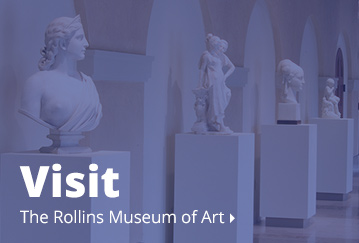Mythological Sculpture in the Cornell Fine Arts Museum Collection
Although best known for its extensive holdings of paintings and prints, the Cornell Fine Arts Museum collection is not limited to two-dimensional works. Our sculptural works include Asian and Christian religious figures and abstract contemporary works side by side with neoclassic statues from Europe and the United States and Japanese warrior and court dolls. In an effort to make our three-dimensional treasures better known, we will be rotating thematic exhibitions in the Orientation Gallery. Our first display was dedicated to Greek and Roman mythology.
A myth, according to the Merriam-Webster Dictionary, is a traditional story of ostensibly historical events that serves to unfold part of the world view of a people or explain a practice, belief, or natural phenomenon. In the Greek and Roman worlds, mythology was largely the story of the majority religion; in post-antique cultures, it became a treasure trove of subjects for artists in all media. The captivating stories and the universality of their symbolism offered an almost endless array of interpretations, assuring the survival of mythology as a source of inspiration through the centuries.
The son of a sculptor from Dijon, Hippolye François Moreau learned his craft originally in his father's studio and then at the École des Beaux-Arts in Paris. Moreau had a predilection for mythological subjects, which may be why the donor of this piece titled it Hero Waving to Leander, in spite of no specific details pointing to the story.
Star-crossed lovers who cannot bear to live without one another are hard to resist by artists: the story of Hero and Leander has been used extensively not only in visual art (from the frescoes of Pompeii to this nineteenth-century sculpture) but also in music and literature. From antiquity's Ovid to Christopher Marlowe in the Renaissance to John Keats during the 1800's, poetry and prose mused on the tragic fate of the young lovers. Georg Friedrich Handel used it as inspiration for his music, as did Robert Schumann and Franz Liszt.


